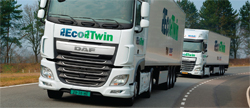 Truck-maker DAF has demonstrated its ‘EcoTwin’ automated truck idea in front of Dutch and Belgian government officials on the N270 near Helmond.
Truck-maker DAF has demonstrated its ‘EcoTwin’ automated truck idea in front of Dutch and Belgian government officials on the N270 near Helmond.
The trial involved two truck combinations – wirelessly linked via WiFi – driving a short distance from each other, with the driver in the second truck not being required to accelerate, brake and steer.
According to DAF, this was the first such demonstration to take place in the Netherlands.
The concept of two trucks cooperating by driving a short distance from each other using automated driving technology has been dubbed ‘2-Truck platooning’. DAF said the intention of its EcoTwin experiment with TNO – the Netherlands Organisation for Applied Scientific Research – was to show the second vehicle is technically able to follow a short distance from the front vehicle, using radar and camera information, thanks to wireless communication between the two vehicles. During this process, the second vehicle can automatically accelerate, brake and even steer.
The manufacturer said the objective of the project is to reduce the gap between the two truck combinations as far as possible, so fuel savings of 10 per cent can be achieved in the long term, along with equivalent reductions in CO2 emissions.
“Just because we have showed ‘automated platooning’ with two trucks is technically feasible, that doesn’t mean we are actually there yet,” said DAF’s chief engineer, Ron Borsboom. “We still need to do quite a lot of development work to ensure the technology is completely reliable in any situation.
“Issues like legislation, liability and acceptance also have to be taken care of properly,” he added. “Along with TNO, we expect transport companies will be able to operate the first trucks using truck platooning safely on Dutch motorways and some major provincial roads by around 2020.”






